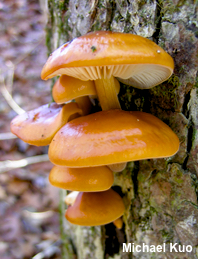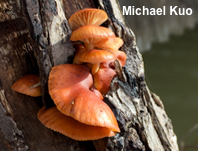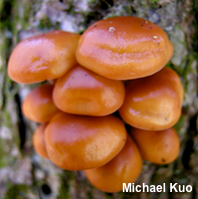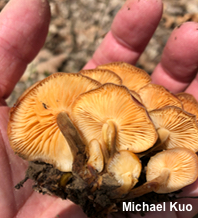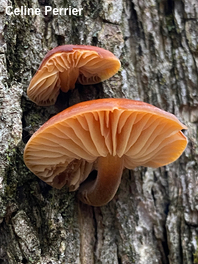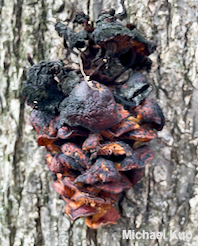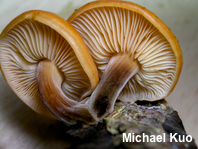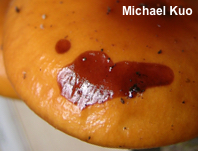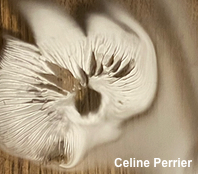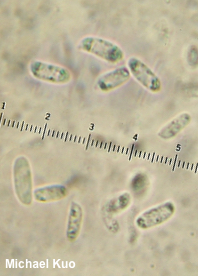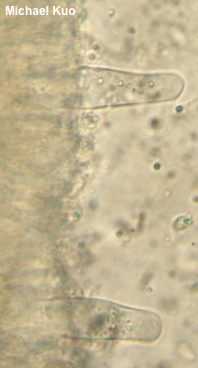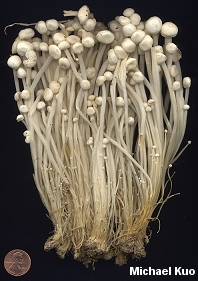| Major Groups > Gilled Mushrooms > Pale-Spored > Collybioid > Flammulina velutipes |

|
[ Basidiomycota > Agaricales > Physalacriaceae > Flammulina . . . ] Flammulina velutipes by Michael Kuo, 12 May 2024 This well known species is fond of cold weather, and often appears in late fall or winter. It has a sticky, almost rubbery, orangish to reddish brown cap, along with a distinctively velvety stem that darkens from the base upward. It grows from the wood of hardwoods—but the wood is sometimes buried, making the mushrooms appear terrestrial. The spore print is white. As it is currently defined, Flammulina velutipes is found virtually across the globe. Flammulina populicola is virtually identical to the naked eye, but is easily separated on the basis of its ecological niche; it grows from the wood of quaking aspen, narrowleaf cottonwood, and other poplars in western North America (and, in Europe, on Populus tremula and other poplars). Identification can be confirmed with microscopic analysis, since the two species have differently shaped pileipellis elements and differently shaped spores. In coastal California, Flammulina velutipes lupinicola is a slightly smaller version that appears on the wood of bush lupines, primarily in back dunes. Flammulina rossica and Flammulina fennae usually feature much paler (often nearly white) caps and differ microscopically; these species are primarily northern and montane. In 1993 cultures of Flammulina velutipes were flown on the Space Shuttle Columbia in order to determine how the mushrooms would handle low gravity (Moore et al. 1996). Like many wood-inhabiting mushrooms, Flammulina velutipes typically bends its stem near the base, then grows straight up, resulting in a cap that is more or less parallel to the ground—presumably so that spores will fall easily from the gills. Aboard the space shuttle, however, the mushrooms got confused, growing out of a simulated tree trunk at all angles. In other words, they lost their balance. Whether or not this result might have been predicted by any tenth grader, and whether or not funding for this experiment came from public sources, are questions I will leave to the reader. I will simply point out that, at about the same time, the United States decided to "end welfare as we know it," because it was too expensive. Believe it or not, the "enoki mushroom" often found in grocery stores and restaurants, also called the "enokitake," is a cultivated form of Flammulina velutipes. It looks nothing like the wild mushroom, however; it is pale, long-stemmed, and tiny-capped (see the bottom illustration). Thanks to Celine Perrier for documenting, collecting, and preserving Flammulina velutipes for study; her collection is deposited in The Herbarium of Michael Kuo. Description: Ecology: Saprobic on the stumps, logs, roots, and living wood of hardwoods and, more rarely, conifers; growing in clusters; sometimes appearing terrestrial; usually appearing from fall to spring; originally described from England (Curtis 1782), and epitypified by Bas (via Redhead & Petersen 1999) from England; widely distributed. The illustrated and described collections are from Illinois and Québec. Cap: 1–6 cm across; convex, becoming broadly convex or flat; sticky when fresh; bald; dark orange brown to orangish brown or yellowish brown; often paler toward the margin; fading with age; the margin becoming lined. Gills: Broadly or narrowly attached to the stem; close, or nearly distant; creamy white to pale orangish; short-gills frequent. Stem: 2–5 cm long; 3–10 mm thick; equal or larger towards base; tough; whitish to pale to yellowish brown or orange brown when young; becoming covered from the base upwards with a dark, brown to blackish, velvety coating; often developing fine longitudinal ridges; occasionally with a long, skinny "root" extending into the substrate. Flesh: White; sometimes yellow in stem base; unchanging when sliced. Odor and Taste: Not distinctive. Chemical Reactions: KOH red to brownish red on cap surface. Spore Print: White. Microscopic Features: Spores 5–10 x 2.5–3.5 µm; subcylindric to elongated-ellipsoid; smooth; hyaline in KOH; inamyloid. Basidia 25–28 x 3–4 µm; subclavate; 4-sterigmate. Pleurocystidia 35–50 x 6–11 µm; widely lageniform to subcylindric; smooth; thin-walled; hyaline in KOH. Cheilocystidia similar to pleurocystidia. Pileipellis an ixotrichoderm; ixohyphidia 1–3 µm wide, cylindric, smooth, hyaline in KOH; terminal elements filiform; pileocystidia scattered, 40–50 x 10–12 µm, subcylindric to sublageniform, smooth, thin-walled. Clamp connections present. REFERENCES: (W. Curtis, 1781) R. Singer, 1951. (Coker & Beardslee, 1921; Smith, 1973; Lennox, 1979; Smith, Smith & Weber, 1979; Phillips, 1981; Moser, 1983; Weber & Smith, 1985; Arora, 1986; States, 1990; Breitenbach & Kränzlin, 1991; Phillips, 1991/2005; Lincoff, 1992; Horn, Kay & Abel, 1993; Bas, 1995; Barron, 1999; Hughes et al., 1999; Redhead & Petersen, 1999; Methven et al., 2000; Nonis, 2001; Petersen, Hughes & Redhead, 2001; McNeil, 2006; Miller & Miller, 2006; Kuo, 2007; Kuo & Methven, 2010; Ripková et al., 2010; Buczacki et al., 2013; Desjardin, Wood & Stevens, 2015; Evenson, 2015; Ge et al., 2015; Siegel & Schwarz, 2016; Baroni, 2017; Gminder & Böhning, 2017; Elliott & Stephenson, 2018; Sturgeon, 2018; Vesterholt, 2018; Læssøe & Petersen, 2019; Kibby, 2020; MacKinnon & Luther, 2021; McKnight et al., 2021.) Herb. Kuo 11199401, 04299501, 11210601, 11010903, 11161001, 01221703, 10242301. This site contains no information about the edibility or toxicity of mushrooms. |
|
|
Cite this page as: Kuo, M. (2024, May). Flammulina velutipes. Retrieved from the MushroomExpert.Com Web site: http://www.mushroomexpert.com/flammulina_velutipes.html © MushroomExpert.Com |
